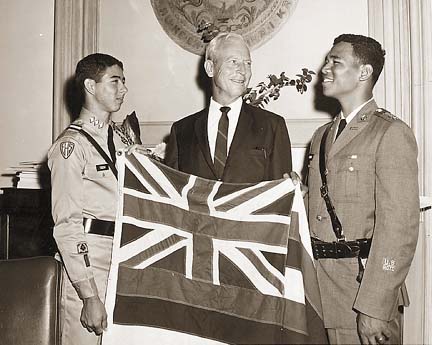

John Anthony Burns

Governor ‘our rock of stability’
Series begins today on those who
By Gregg K. Kakesako
shaped isles this century
Star-BulletinJohn Anthony Burns had a Jacksonian faith in Hawaii's common people and their potential for growth and greatness.
As the politician who shepherded Hawaii into statehood in 1959, Burns served three terms as governor before dying of cancer in 1975. Although Burns would never claim he single-handedly brought statehood to Hawaii or that he led the revolt which brought the downfall of the territory's plantation oligarchy, he led much of its planning and implementation.
Hawaii Tourism Authority chief Bob Fishman, who worked as an aide for Burns first in 1969 and then on the 1970 gubernatorial campaign, said Burns "was always considered to be the state's grandfather figure, even though he wasn't that old when he died."
"He was considered our rock of stability," Fishman said. "Some people even called him 'the great stone face.' He was an extremely moral individual who attended church almost every day."
Fishman, who has served under several other governors, added: "I know he understood very clearly that he was building a new foundation for the state. He felt very passionately about doing away with social inequities, first for the AJAs (Americans of Japanese ancestry), and then extending it to other groups like the Filipinos and even the haoles from the mainland."
The rise of racial, economic and social democracy and the push for a more diversified economy were hallmarks of Burns' legacy, Fishman added.
"That extended especially to helping the neighbor islands," he said. "The neighbor islands then had no economic foundation. It was experiencing a tremendous brain drain. He helped find the sparks of energy, and put money into building schools and libraries and hospitals there."
A policeman, architect of the modern-day Democratic Party, social revolutionary, twice territorial delegate to Congress and finally governor for 12 years, Burns had a vision for Hawaii. It was one dealing with expanding equality, education and economic opportunity. He worked to establish the East-West Center while a delegate to Congress, and as governor he pushed for the development of the law and medical schools at the University of Hawaii.
Born on March 30, 1909, in Fort Assinneboine, Mont., the eldest son of four children of an Army sergeant major, Burns came to Hawaii at the age of 4 when his father was transferred to Fort Shafter. Raised in Kalihi, Burns graduated from St. Louis High School in 1930 and attended the UH for only a year, driven to work by the Depression.
Married to Beatrice Majors Van Fleet, Burns by 1934 was a member of the Honolulu Police Department and, rising quickly through the ranks, was a captain when war broke out with Japan. During World War II, he helped form a community liaison group with members of the Japanese community. His insistence that Americans of Japanese ancestry be treated fairly helped create the famed 100th Battalion and the 442nd Regimental Combat Team.
Burns sought to be Hawaii's first governor after statehood in 1959, but lost to Republican William Quinn. However, he beat Quinn in 1962 and was re-elected in 1966 and 1970.
In a 1964 interview, Burns noted: "I never saw the acquisition of material wealth as a sign of success. Public service became a strengthening cause to me. Public service is probably the best way for a layman to carry out his sense of social responsibility."
Today, we start our millennium-ending look at "100 Who Made a Difference" in Hawaii, people who moved and shook our community this century. Series begins today on
those who shaped isles
this centuryEach day through year's end, we'll profile one person , examining how she or he made a difference here.
Picking the 100 was a daunting task. We ultimately decided to exclude notables who lived outside of this century, such as Kamehameha, Princess Pauahi Bishop and Father Damien.
Some people said we were foolish to even attempt this project. That everyone wouldn't agree with our choices. That, surely, we would leave out other deserving figures. Yes, yes and yes.
Still, we tossed the net wide, requesting nominations from readers, in print and online. We solicited names and feedback from key leaders around town, from a range of fields and disciplines.
Here's the goal: to recap Hawaii's 20th-century history and growth through some of its people. And to inform: Hawaii's past does hold clues toward a wiser future.
Agree or disagree. But the main thing is, read all about them.
Lucy Young-Oda, art director & special projects